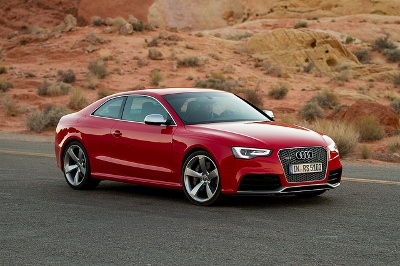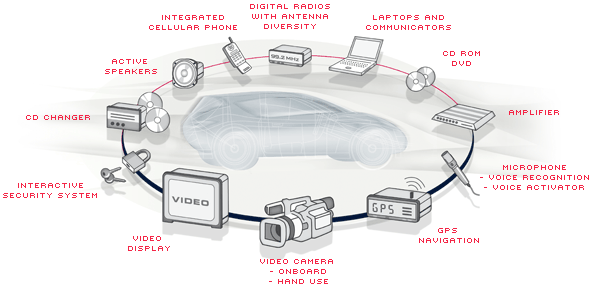 Today’s cars are full of the latest electronic toys, making them a moving office and entertainment center all in one.
Today’s cars are full of the latest electronic toys, making them a moving office and entertainment center all in one.
We have CD players, iPod ports, Bluetooth connections to our smartphones, Sat Nav with instant traffic feedback, front/rear view cameras, sensors, radar distance control to the car in front and voice activated controls, to name just a few. And this trend is increasing – cars are really becoming connected, mobile computing platforms that happen to have a steering wheel.
The growth of automotive electronics
However how many of us actually think about what’s there and what makes it work? We probably take it for granted, as these electronics are now an integral part of what makes our driving experience so engaging and safe. So what powers these systems and where are they located?
The current trend in automotive design seems to favor putting the electronic hardware in the trunk (boot). These little boxes of electronics need a power supply, which is easily supplied from the nearby battery, to be kept cool and safe behind rear panels hidden away from prying fingers and the sun, and most importantly incoming and outgoing data signals.
Let’s take a closer look at the data requirements of today’s modern car. It has grown from audio at 5.6Mb/s through basic video at 25Mb/s to HD video at 150Mb/s and now 1Gb/s for perimeter monitoring cameras. As in every environment, demand is forever growing as new applications and sensors are added all the time.
The options for getting data quickly around the car
So having established that there is a growing requirement for high data rates in automotive wiring system what are the options available to manufacturers?
Essentially they split into three groups:
- Copper twisted pair
- Co-axial cables
- Fiber optic connections
- Glass
- Plastic Optical Fiber (POF)
Each has its strengths and weaknesses:
- Copper twisted pair – Mechanically strong, robust and simple interconnect technology but limited on data rates at higher levels and suffers from possible interference from other devices in the vehicle platform.
- Co-axial cables – Mechanically strong, robust and simple interconnect technology but bulky, less flexible and heavy, making it bad for overall vehicle weight.
- Fiber Optics (glass) – while glass has a fantastic data rate capability it needs a good sheath package to make it robust, it is not easy to terminate and there are question marks over how it handles vibration.
- Fiber Optics (POF) - has good mechanical strength, easy to cut and terminate on the manufacturing shop floor (as no splicing or polishing is required), robust with respect to vibration, lightweight, no danger of interference, and ideal for short transmission distances. It now has volume deployments in vehicle platforms. POF does have bandwidth and distance limitations compared to glass fiber, although current research aims to increase capacity to gigabit levels.
 The challenges of Plastic Optical Fiber
The challenges of Plastic Optical Fiber
POF therefore looks like the perfect choice for automotive applications. However it has not been without some issues in its relative short history of deployment in vehicles. During its early days there were issues with the product, within a main wiring loom, being stressed during installation.
These main wiring looms are large bulky assemblies made in factories away from the assembly line. During the installation of such large complicated (mainly copper) assemblies a certain amount of bending, pushing, and stress are applied to get the loom into its permanent place within the vehicle platform. Let’s not forget that the wiring loom passes through multiple parts on a vehicle and that routing is never a straight line. Installation is happening on a live, moving production line, meaning the job has to be done as quickly as possible to maximize productivity. This bending and stress causes breaks in the POF – either visible on the production line or showing up during QA tests on the finished car.
Bear in mind that cars have a design lifetime of 20 years. This means that POF needs to last at least as long and be protected from vibration and impact, not just during manufacture, but over a long period after the vehicle has been built. Obviously no manufacturer wants the cost of having to refit the main wiring loom – or the potential PR disaster of cars failing in the market. So how can they protect the POF in such situations?
It comes down to fiber protection tubing. This is placed strategically over the POF in areas where stresses during installation are anticipated, such as main bend areas and where the POF exits the wiring loom. The automotive industry has tried other, more basic, slit tubes such as corrugated tubing, but none of these have the combination of flexibility, strength and lightness. In the case of our Miniflex tubing, which is used in thousands of cars, it has a track record in protecting vital communication fibers in confined spaces, being installed inside fighter jets, space missions and telescopes as well as in broadband deployments.
Looking to the automotive future
The automotive industry is moving very fast towards making cars more intelligent, with even more sensors, leading to an ever-greater hunger for higher transmission rates from the wiring loom, and making protection even more vital. I am sure it won’t be long before we will program a destination into our driverless vehicle, sit back, relax and watch a 3D film, while being whisked along in seamless luxury, automatically avoiding any traffic jams.
So next time you drive your car and appreciate the fantastic sound system or are saved by the parking cameras from a minor knock, give a thought for the few feet of protective tubing that could well have made the whole infotainment process possible.
Image 1 by Josh Sniffen, Image 2 by MOST


